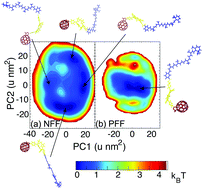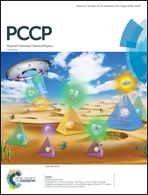Induced polarization restricts the conformational distribution of a light-harvesting molecular triad in the ground state†
Abstract
The light-harvesting molecular triad consisting of carotenoid polyene (C), diaryl-porphyrin (P) and pyrrole-fullerene (C60) is a donor–acceptor molecule capable of absorbing incident light in the visible range. Its ability to convert solar energy to electrical excitation and charge separation energy suggests a great potential in real-world applications. The ensemble of its conformations under ambient conditions varies widely according to its electronic state. In previous work, we applied a non-polarizable model to study the conformational distribution of the molecular triad in the ground and charge separated states. However, due to the lack of polarization, which imparts subtle changes in the charge distribution on atoms, molecular simulations fail to produce accurate average dipole moments. We developed the first polarizable model for a molecular triad to investigate the structural and dynamic properties of a molecular triad in the ground state in an explicit organic solvent, tetrahydrofuran (THF). We performed first-principles electronic structure calculations of the individual components in the triad as well as THF and then fit the partial atomic charges to the electrostatic potential using the i-RESP methodology. We validated these force field parameters by comparing the thermodynamic and dynamic properties obtained from molecular dynamics simulations with those from experiments. We enhanced the sampling of the triad conformations with replica exchange molecular dynamics simulations. We characterized the effects of induced polarization on the structural stability of the triad by analyzing the free energy landscapes constructed with polarizable force fields. Furthermore, by using principal component analysis, we found that the molecular triad conformations adopted a small range of torsional angles with induced polarization. The triad conformation solvated in polar solvent with a polarizable force field qualitatively agrees with that obtained from nuclear magnetic resonance spectroscopy.



 Please wait while we load your content...
Please wait while we load your content...